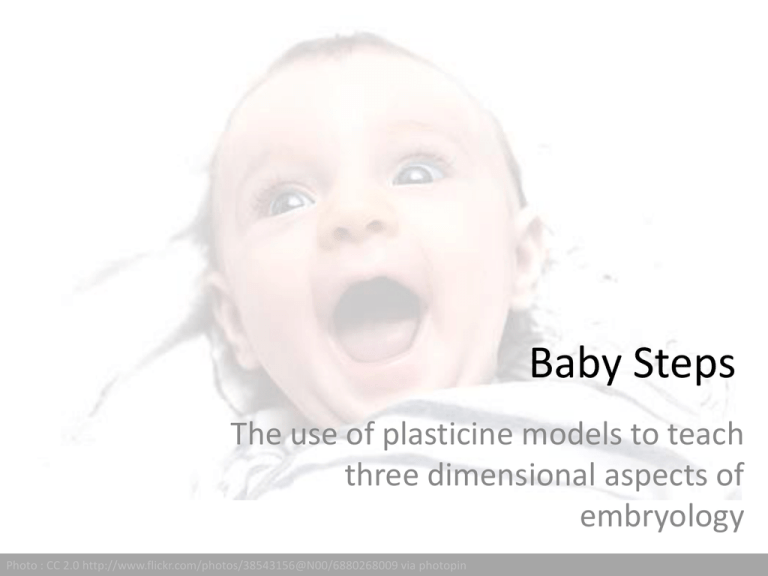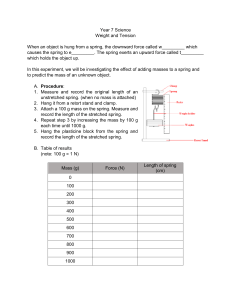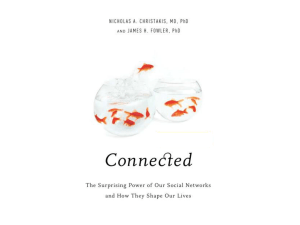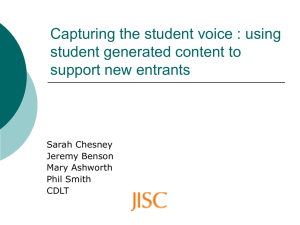Baby Steps: the use of plasticine models to teach three
advertisement

Baby Steps The use of plasticine models to teach three dimensional aspects of embryology Photo : CC 2.0 http://www.flickr.com/photos/38543156@N00/6880268009 via photopin Before we start….. ectoderm mesoderm endoderm Embryology CC 2.0 photo - http://www.flickr.com/photos/68132273@N00/6769198509 & http://www.flickr.com/photos/45767493@N00/8855228722 via photopin CC 2.0 photo - http://www.flickr.com/photos/41091619@N00/6748755607 via photopin Why plasticine? CC 2.0 photo - http://www.flickr.com/photos/57930896@N06/7229636064 via photopin Difficult…. • • • • Early in curriculum New terminology – aligned with anatomy Thinking in 3 dimensions, resources in 2d Students ask for more teaching/extra sessions, or email for help Evidence • Increasing enthusiasm and engagement (Handfield Jones) • Aiding observation, communication skills and personal development (de la croix) • Life drawing enhances engagement but not content knowledge of anatomy. (Collett et al) • Approaches to 3 dimensions – sculpture, (Powley & Higson)computer modelling (Kakusho, 2001) and living anatomy models. 2013/4 2014/5 Facilitated self directed learning session –from egg to birth Plenary : Fetal development – what is normal? Facilitated self directed learning session –intrauterine development Life sciences : Female reproductive tract and first 2 weeks Flipped classroom session : Intrauterine development and placenta Preparation Session Resources Activity • Create a ‘trilaminar disc’ Questioning • • • • • Is it completely round? What features might you see on it? What do these features represent? What week of development are we in? What happens next? Week 3 Primitive streak Neural plate – development of the nervous system Neural crests Crests fuse Cranial neuropore – site of brain development Caudal neuropore – site of cauda equina development (end of spinal cord) Folding Somites/spinal cord segments Ectoderm Structures that maintain contact with the outside world Eg CNS PNS Sensory apparatus of ear,nose, eye Epidermis, hair and nails Plus Subcutaneous glands Mammary glands Pituitary gland Enamel of teeth Mesoderm Vertebral column Dermatomes Myotomes Urogenital structures Peritoneal, pleural and pericardial lining Haemopoeitic stem cells Endoderm GI Tract Epithelial linings of respiratory tract, urinary bladder and urethra, tympanic cavity and auditory tube. Parenchyma of thyroid, parathyroids, liver and pancreas Formation of brain vesicles at cranial neuropore Week 7 onwards… • Picture of the models • Outline features eg of neurological development • What happens in folding • What abnormalities could arise Observations on session • • • • Engaged /enjoyment Student Questioning - somites Some students went a bit off piste… Time was limited 61 positive comments 17 points for improvement Feedback “Plasticine is really helpful.” Spatial awareness 3d understanding Hands on Engagement “Fun, interactive. Keeps me more awake” “Very different, good last session of an intense day. “ “Enjoyed the session it was very interactive” “Great, helpful to visualise everything” “Very practical session. Helped us imagine” “The plasticine helped to reinforce learning – really fun and useful!” “The plasticine activity would make me remember what we learnt. Loved it. “ FUN ! Misconceptions • “I liked the session. Helped explain the shape of the bilaminar disc and how it binds” • “For gastrulation it explains the process really well, also fun” • Some wanted more time – as they hadnt understood heart aspects • Some felt they wanted it to be more complex and challenging • Some felt the session was too long for the content • Some felt that we didn’t cover much – more reinforcing the learning from the lecture Improvement points • “More accessible powerpoint – too small and complex” • “We could have gone through the placenta a bit more, rather than having to look at dle after.” • “Possibly provide more resource links for self directed learning.” • “More time on how the cardiac loop becomes the heart” How does this translate to performance? References Med Teach. 1993;15(1):3-10. Creativity in medical education: the use of innovative techniques in clinical teaching. Handfield-Jones R1, Nasmith L, Steinert Y, Lawn N A digital tool for three-dimensional visualization and annotation in Anatomy and Embryology learning ORIGINAL ARTICLE Eur. J. Anat. 17 (3): 146-154 (2013) Jon-Jatsu Azkue Does ‘doing art’ inform students' learning of anatomy? T J Collett and J C McLachlan Medical Education Volume 39, Issue 5, page 521,May 2005 The Arts in Medical Education: A Practical Guide – Jun 2005 by Elaine Powley (Author)




